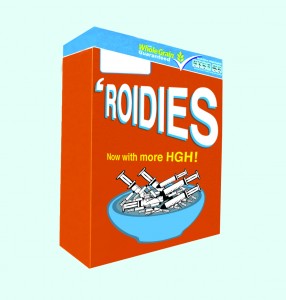Champions need chemicals to excel; make steroids mandatory

Graphic By Carla Butwin
I have seen the future, and it is full of angry, bulky, pimply men.
I was thrilled to hear play-by-play sports commentator Brent Musburger’s comments about steroid use to University of Montana journalism students last week. His argument was that steroids get results. If professional sports players are going to keep using steroids regardless of whether or not it’s allowed, why not just legalize it?
And what about the wrongfully-prosecuted accidental steroid users, who “never knowingly took steroids,” whose only crime is not reading labels?
Does Rafael Palmeiro deserve to have his career tarnished for a simple misunderstanding? To quote the man himself, “I thought they were antacids.”
We spend so much time investigating steroid use just to see if our sports accomplishments are legitimate. What does it matter if Barry Bonds can hit a baseball at the speed of sound? The important thing is, he can. We should spend less time worrying about what Bonds pumps into his body, and more time worrying about the low-flying aircraft threatened by steroid fueled grand slams.
I can tell that Musburger is on to something here. This is where we’re headed. I gassed up The Oakland Post time machine and took a trip to the year 2030 to find out how sports have changed after the 2022 legalization of anabolic steroids and steroid injections are mandatory in baseball.
Upon my arrival at Comerica Park, I noticed several changes to the traditional baseball diamond. First off, the field has bulletproof glass barriers erected around the perimeter to protect sports patrons from home runs.
Bats are made of vibranium alloy to better withstand the explosive force of a roid-fueled pitch meeting a roid-fueled swing. A charity organization has been created to compensate the widows of players killed by bean balls.
New padded uniforms have been issued to players who develop man-breasts. Therapists are on staff during the game to counteract the effects of irrational chemical induced rage between innings.
I also noticed that in 2030 a hot dog and a can of Coke at Comerica Park costs $30.75. So some things haven’t changed.
I found the once disgraced Jose Canseco now proudly adorns the Wheaties box, and is recognized as a pioneer in the field of doping.
Pump up the jam
But baseball is not the only sport that has been changed by legal steroid use, as I quickly learned. Brett Favre texted me a picture of his shrunken testicles within minutes of my arrival in the future.
Hockey revolves almost entirely around fighting. The winner is usually the team with the fewest players ejected by referees, and penalty boxes can fit ten players with bulging biceps.
The Winter Olympics are in controversy over whether to disqualify figure skaters who smash the ice following a fifteen-foot triple Salchow.
Curling has exploded in popularity as the curling community embraced the shift to mandatory steroid usage. The curling lanes are four kilometers long, and new rules were created to govern scoring for pieces of shrapnel from shattered curling stones. Some leagues allow players to use snowmobiles to keep pace with the stones.
Speed swimmers must be shaved hourly to counteract out of control hair growth and maintain their aerodynamic sleekness. In track and field, runners’ lanes have been widened to accommodate their massively muscular thighs, which also must be oiled before each heat to prevent chafing.
Basketball has transformed into the video game version of basketball, with players routinely leaping up into the rafters and performing 720 backflip slam dunks. To keep pace, video game basketball has become even more ridiculous. Pro tip: Rodney Stuckey’s laser beam eyes technique in NBA Jam 2029 is the most useful move in the game.
Brand new sports have been developed as well. Equestrian dodgeball, the most violent sport I saw, was created when two college club sports lacking enough members merged. By 2030, it’s become a Division I sport. A no-holds-barred, underground version has become a hotbed for gambling.
However, new diseases have been transmitted to humans, as steeds and riders sharing a supply of horse steroids occasionally swap needles.
School spirit
But just as Musburger said, steroids should have no place in high school sports. I mean, we’ve got to draw the line somewhere. Steroids intermingling with out-of-control teenage hormones would result in sheer pandemonium.
Nonetheless, a new scandal has arisen over young athletes imitating their sports heroes, encouraged by team coaches to get the edge over the competition. Some school administrators have discussed legalizing steroids for grades seven and up.
Something we didn’t anticipate is that the rampant acne you get in high school makes you more popular instead of a social pariah.
I should probably wrap this up. After my enlightening trip to the future, I took a quick jaunt back to 1996 to pick up a six-pack of Surge. But I probably stepped on a butterfly or some crap because now my left hand keeps disappearing and I’ve have had to type this whole article with my right.
While I still have a corporeal hand, let me use it to raise a toast to the future of professional sports. Violent, chemical-fueled sports.


